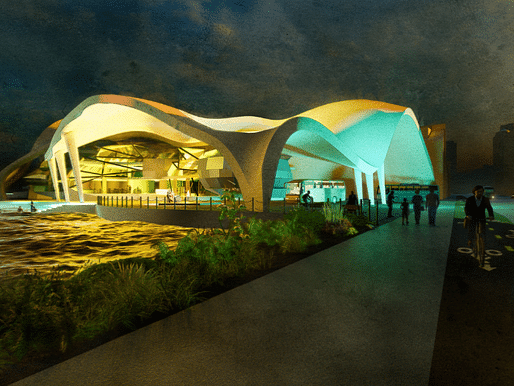
If life had gone differently, Nathan Rosazza would have spent his time playing guitar on stage. “I never really cared about school,” he says. “I just wanted to be a rockstar.” He dropped out of high school, earning a GED instead, and worked backbreaking warehouse jobs in western Massachusetts, all the while continuing to write songs and play in bands.
When he turned 30, however, he started to realize that perhaps his dream of being a rockstar wasn’t going to happen. He remembered a conversation he had with a mentor a decade earlier when he was thinking about a job in construction or carpentry. “He suggested my personality was more suited to being an architect,” he says. “It kind of planted a seed. Nathan eventually planted that seed, growing it into a career. He had always enjoyed drawing, as well as writing and recording songs, and now set about applying that creative mindset to designing buildings. He joined the Air Force Reserve and began taking architecture classes at a local community college, finding to his surprise that he actually got good grades. “I just had a strong determination to make it happen,” he says.
Starting the path to becoming an architect in his thirties, however, made Nathan feel like he had to make up for lost time. When he heard about the IPAL program at the BAC, he felt it was the perfect opportunity to earn his degree and license in the fastest way possible. “I just decided I was going to put my head down and plow through everything as fast as I could,” he says. “I had to play catchup.”
In studios at the BAC, he realized the process of creating an architectural design was more similar to creating music than he’d imagined. “When teachers described how the design process works like you can start messing around sketching and seeing what comes out, and sometimes you’ll get far along and realize you want to start over, and you throw out some of it and keep some of it,” he says. “It just reminded me the whole time of my process for writing songs.”
For his thesis, Nathan naturally explored the relationship between architecture and music, finding that he was not the first person who had made a connection between the two fields—and actually, there was a rich tradition of scholarship relating building to music theory. “I started out exploring what are the rules for creating a song that is going to create something beautiful that everyone can appreciate—and are there rules for architecture that you can carry over to help someone learn about the fundamental things that make for a beautiful design.”
The experience also opened Nathan up to new creative challenges, in learning how to design spaces that would suit the needs of people who were going to be using them. “It definitely changed me as a person, to be open to new ideas,” he says. “You’re always having to think about what would be good for people, and totally open up your mind to something that would make sense at the same time fit all of the parameters you’ve been given.” At the same time, Nathan nurtured his nascent drawing skills, finding he had a talent for architecture renderings. “It’s definitely a strength I have compared to the average person working in an architecture office,” he says. “And I think it’s also related to music because it has to be emotional and use imagination to create an impression of what a space can be.”

While taking classes at the BAC, he worked in the architecture office of a professor at the community college, A.W.Nardi, commuting from Western Massachusetts to Boston. The schedule of trying to earn his architecture degree as a bachelor’s of architecture student was definitely demanding for him, especially with a partner and young children at home. Ironically the lockdown from the pandemic helped him create more work-life balance as school went online. “We were close to the breaking point when everything shut down,” he says. “So it was really nice when that happened for us. I was able to focus.”
In the end, Nathan fell one day short of completing all of his exams by the time he finished his degree, passing his last exam the day after he graduated. Completing the BAC’s IPAL program, however, allowed him to earn his architecture license and start practicing within only a few years of deciding to follow that dream.
Nathan now practices as an architect at Nardi’s firm, Uncommon Architectural Places, working on both renovations and new builds for restaurants, apartments, and commercial buildings, creating almost all of the renderings for the office—and even teaching as an adjunct professor at a local community college. While he still practices music as a hobby, Nathan says the BAC helped him make up for lost time in his career. “The ability to get your exams down while going to school is such a great way to save time if you can do it,” he says. “It was definitely the right fit for me.”

The #BACbuzz blog will help to inform, educate, and share relevant and noteworthy architectural and design news happening within the Boston Architectural College and around the Boston community.
No Comments
Block this user
Are you sure you want to block this user and hide all related comments throughout the site?
Archinect
This is your first comment on Archinect. Your comment will be visible once approved.